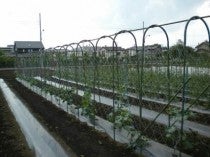The Advantages or Trellising Cucumbers
Once the beam was set we double-checked for straightness and to make sure each arch met the cross bar. Where it didn’t we pushed and pulled it down to set it evenly as well as snugly. Then we wrapped more rubber bands around the ends to further strengthen and secure the structure in anticipation of the increased weight of the vines as well as any weather. (Something that paid off when the recent typhoon blew through.) As the vines fill out, I imagine the trellis will become a sort of green edifice in the middle of the farm that the wind will steadily attempt to topple. Two poles on either end of the structure set in at angles and held with thin wire reinforce the whole.
Over all of this we strung a net that essentially hangs to the bottom on both sides. We ran the base string out first, and then put the ends through the loops on the bottom of the net on either side. This saved us from trying to sew it through after the net was up. It also gave us a bottom ‘rail’ when it was finally time to spread the net out entirely. We then tied the base string to each end pole.
Once the net was secured to the farmer’s satisfaction, we placed the vines. Planted nearly three weeks ago and kept under row covers until just recently, the vines thrived. Some already possessed the signature yellow trumpet-like flowers while still others showed off tiny cucumbers. These first were slightly mottled in appearance, which I’m betting was due to the then irregular rains. (Now that the rainy season is officially underway in what seems like unending precipitation it may be a non-issue.) Working both sides of the structure we alternated which plants went right or left. This ensures both balance in terms of weight but also plenty of room for the vines to grow and spread.
Gently lifting them up we set them in place on the nets, making sure that none of the plant remained on the plastic mulch below, but at the same time wasn’t strained in it’s stretch to it’s new place. A second stake stretching from the base of each plant to the net was set for more reinforcement. The vines, while presenting a prickly exterior on vine and leaf that makes one wish for sturdy gloves and long pants, are also surprising fragile. Hollow as they are one wrong move can result in a break that disrupts the flow of nutrients from roots to leaves to fruit and back again that opens the door to illness, low-productivity or straight up death.
Joan Bailey
https://popcornhomestead.blogspot.com/




 Your Privacy Choices
Your Privacy Choices
Where do you get the U arch? And did the blossoms & young fruit suffer transplant shock? I’ve been taught to remove any fruit from transplants, as it weakens the plant at a critial time.
Thanks for the article!
Very informative! This can be a source of inspiration for all gardening enthusiasts who want to learn more about gardening. Thank you for sharing this wonderful piece.